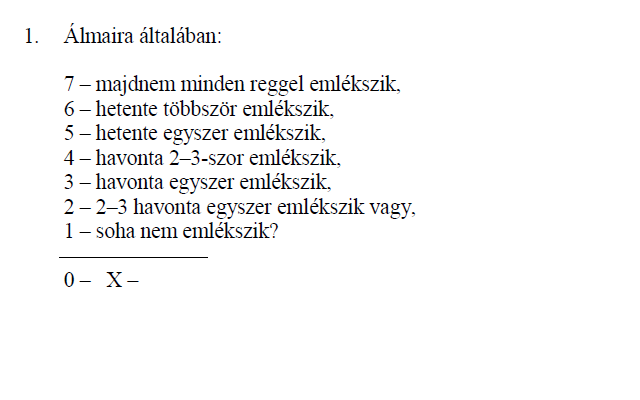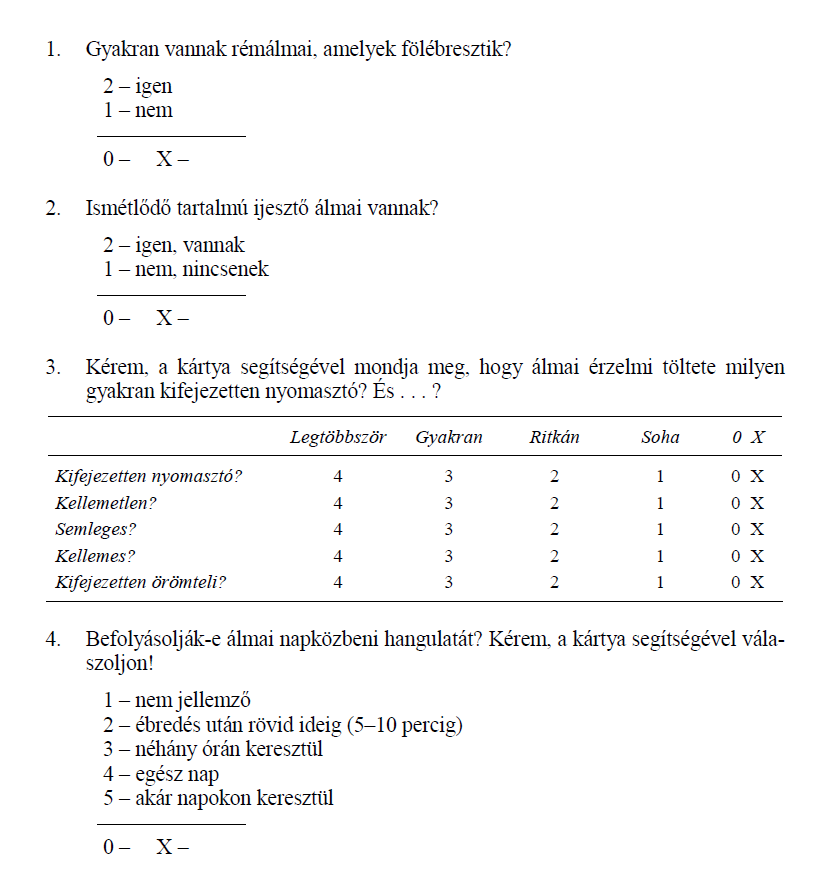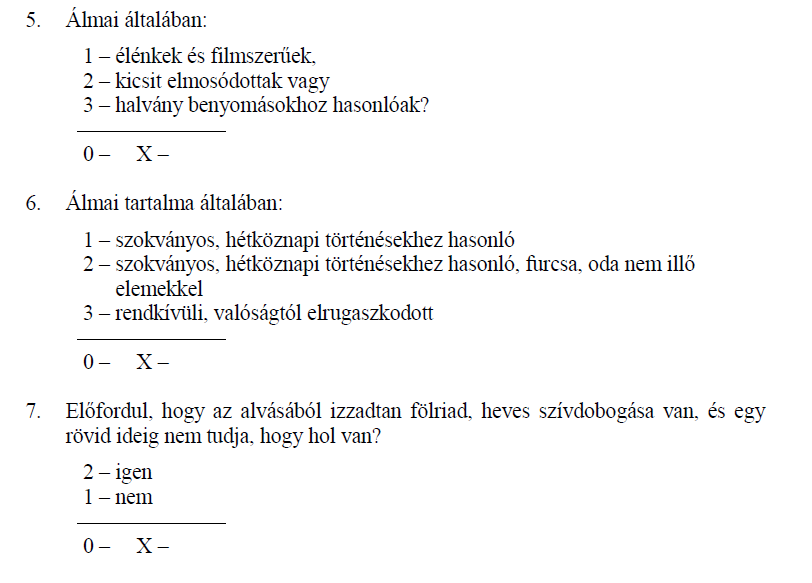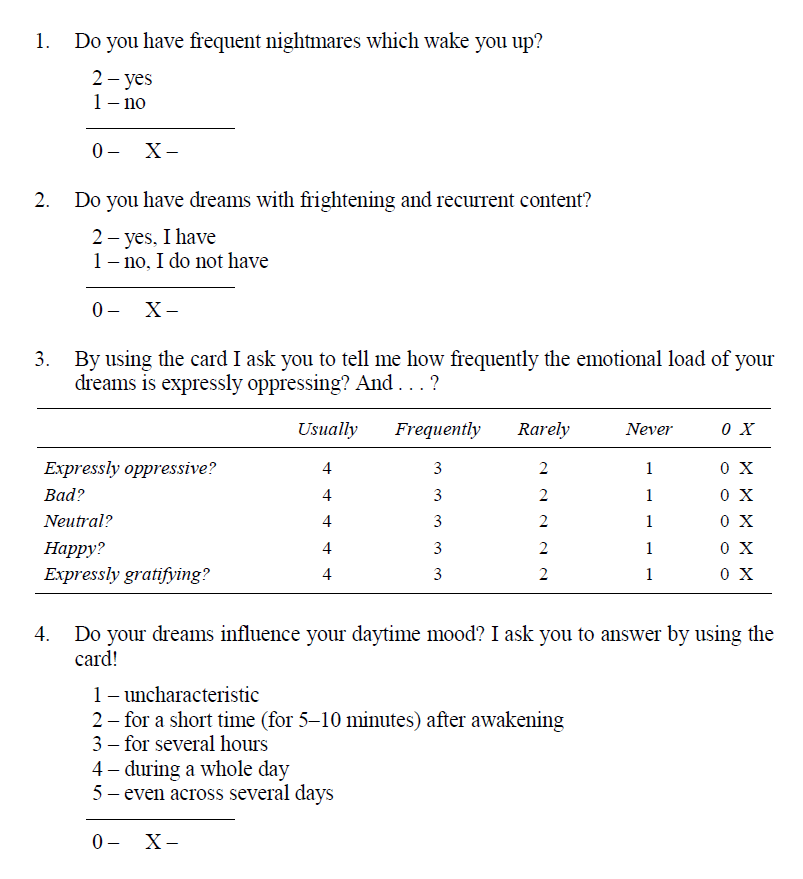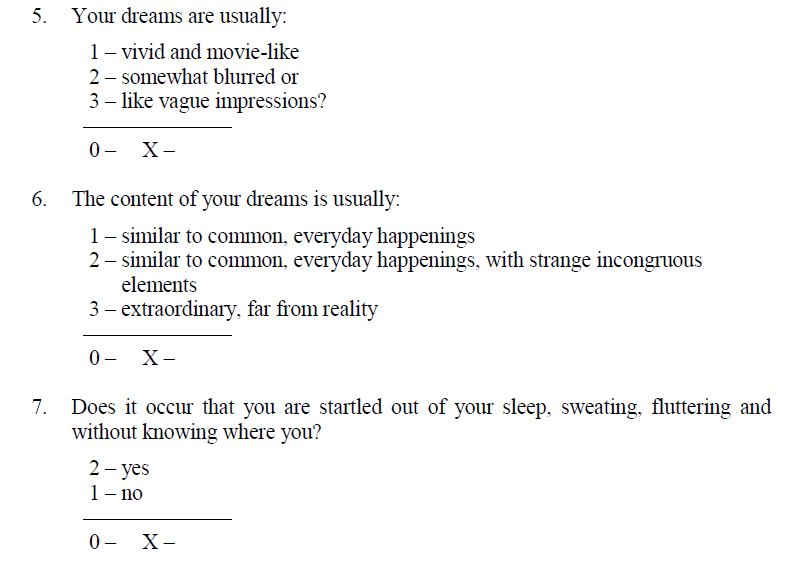|
Page 7 of 7
References
ASPLOUND, R. (2003) ‘Nightmares, Sleep and Cardiac Symptoms in the Elderly’, The Netherlands Journal of Medicine 61:7, 257–61. BECH, P., K. STAEHR-JOHANSEN, & C. GUDEX (1996) ‘The WHO (Ten) Well-Being Index: Validation in Diabetes’, Psychotherapy and Psychosomatics 65, 183–90. BLAGROVE, M., L. FARMER, & E. WILLIAMS (2004) ‘The Relationship of Nightmare Frequency and Nightmares Distress to Well-Being’, Journal of Sleep Research 13:2, 129–36. BÓDIZS, R. (2000a) Alvás, álom, bioritmusok (Budapest: Medicina). BÓDIZS, R. (2000b) ‘Az alvás és az álmodás pszichobiológiája’ in M. NOVÁK, ed., Alvás- és ébrenléti zavarok diagnosztikája és terápiája (Budapest: Okker) 67–86. BÓDIZS, R. (2003) ‘Az alvás és jelenségköre’ in Cs. PLÉH, B. GULYÁS & GY. KOVÁCS, eds., Kognitív idegtudomány (Budapest: Osiris) 601–18. BÓDIZS, R. (2005) ‘Álomképek és agyműködés: percepció vagy koncepció?’, Pro Philosophia Füzetek 42, 73–85. BÓDIZS, R. (2006) ‘Az életminőséggel kapcsolatos jelenségek idegélettani vonatkozásai’ in M. KOPP & M.E. KOVÁCS, eds., A magyar népesség életminősége az ezredfordulón (Budapest: Semmelweis Kiadó) 37–47. BÓDIZS, R. & S. CSÓKA (2007) ‘Ébrenlét és alvás: módosult tudatállapotok és tudatállapotmódosulások’ in P. HALÁSZ ed., Tudat és tudatváltozások (Budapest: Novartis/Látványos Stúdió) 31–50. CARTWRIGHT, R., A. LUTEN, M. YOUNG, P. MERCER & M. BEARS (1998) ‘Role of REM Sleep and Dream Affect in Overnight Mood Regulation: a Study of Normal Volunteers’, Psychiatry Research 81, 1–8. CARTWRIGHT, R., M.Y. AGARGUN, J. KIRKBY & J.K. FRIEDMAN (2006) ‘Relation of Dreams to Waking Concerns’, Psychiatry Research 141, 261–70. DOMHOFF, G.W. (2001) ‘A New Neurocognitive Theory of Dreams’, Dreaming 11, 13–33. ENG, T.C., D. KUIKEN, M.N. LEE & R. SHARMA (2005) ‘Navigating the Complexities of Two Cultures: Bicultural Competence, Feeling Expression, and Feeling Change in Dream’, Journal of Cultural and Evolutionary Psychology 3, 261–79. FLEMING, J.A.E. (1994) ‘REM Sleep Abnormalities and Psychiatry’, Journal of Psychiatric Neuroscience 19:5, 335–44. FOULKES, D. (1999) Children’s Dreaming and the Development of Consciousness (London: Harvard University Press). FREUD, S. (1999) The Interpretation of Dreams, ed. R. ROBERTSON, trans. J. CRICK (Oxford: Oxford UP). GERMAIN, A. & T.A. NIELSEN (2003) ‘Sleep Pathophysiology in Posttraumatic Stress Disorder and Idiopathic Nightmare Sufferers’, Biological Psychiatry 54, 1092–98. GOTTESMANN, C. (1999) ‘Neuropsychological Support of Consciousness during Waking and Sleep’, Progress in Neurobiology 59, 469–508. GOTTESMANN, C. & GOTTESMANN, I. (2007) ‘The Neurobiological Characteristics of Rapid Eye Movement (REM) Sleep Are Candidate Endophenotypes of Depression, Schizophrenia, Mental Retardation and Dementia’, Progress in Neurobiology 81, 237–50. GREENBERG, R., H. KATZ, W. SCHWARTZ & C. PEARLMAN (1992) ‘A Research-based Reconsideration of the Psychoanalytic Theory of Dreaming’, Journal of the American Psychoanalitic Association 40, 531–50. HARTMANN, E. (1996) ‘Outline for the Theory on the Nature and Functions of Dreaming’, Dreaming 6, 147–70. HOBSON, J.A. (1988) The Dreaming Brain (New York: Basic Books). HOBSON, J.A. (2004) ‘A Model for Madness?’, Nature 430, 21. HOBSON, J.A. & R.W. MCCARLEY (1977) ‘The Brain as a Dream State Generator: An Activation Synthesis Hypothesis of the Dream Process’, American Journal of Psychiatry 134, 1335–68. HOBSON, J.A., E.F. PACE-SCHOTT & R. STICKGOLD (2000) ‘Dreaming and the Brain: Toward a Cognitive Neuroscience of Conscious States’, Behavioral and Brain Sciences 23, 793– 842; Discussion 904–1121. KAHN, D., E. PACE-SCHOTT & J.A. HOBSON (2002) ‘Emotion and Cognition: Feeling and Character Identification in Dreaming’, Consciousness and Cognition 11, 34–50. KAI-CHING YU, C. (2006) ‘Memory Loss is not Equal to Loss of Dream Experience: A Clinicoanatomical Study of Dreaming in Patients with Posterior Brain Lesions’, Neuro-Psychoanalysis 8:2, 191–98. KOPP, M.S., Á. SKRABSKI & S. SZEDMÁK (2000) ‘Psychosocial Risk Factors, Inequality and Self-Rated Morbidity in a Changing Society’, Social Science and Medicine 51, 1350–61. KOPP, M.S., Á. SKRABSKI, J. RÉTHELYI, I. KAWACHI & N. ADLER (2004) ‘Self Rated Health, Subjective Social Status and Middle-Aged Mortality in a Changing Society’, Behavioral Medicine 30, 65–70. KRAKOW, B. & A. ZADRA (2006) ‘Clinical Management of Chronic Nightmares: Imagery Rehearsal Therapy’, Behavioral Sleep Medicine 4, 45–70. LEVIN, R. & T.A. NIELSEN (2007) ‘Disturbed Dreaming, Posttraumatic Stress Disorder, and Affect Distress: A Review and Neurocognitive Model’, P MAQUET, P., P. RUBY, A. MAUDOUX, G. ALBOUY, V. STERPENICH, T. DANG-VU, M. DESSEILLES, M. BOLY, F. PERRIN & P.A.A. MAQUET (2000) ‘Functional Neuroanatomy of Normal Human Sleep’, in A.A. BORBÉLY, O. HAYAISHI, T.J. SEJNOWSKI & J.S. ALTMAN, eds., The Regulation of Sleep (Strasbourg: HFSP) 86–93. MIRÓ, M. & M.P. MARTÍNEZ (2005) ‘Affective and Personality Characteristics in Function of Nightmare Prevalence, Nightmare Distress, and Interference due to Nightmares’, Dreaming 2, 89–105. MUZUR, A., E.F. PACE-SCHOTT & J.A. HOBSON (2002) ‘The Prefrontal Cortex in Sleep’, Trends in Cognitive Sciences 6, 475–81. NIELSEN, T.A. (2000) ‘A Review of Mentation in REM and NREM Sleep: ‘Covert’ REM Sleep as a Possible Reconciliation of Two Opposing Models’, Behavioral and Brain Sciences 23, 851–66; discussion 904–1121. NIELSEN, T.A. & P. STENSTROM (2005) ‘What Are the Memory Sources of Dreaming?’, Nature 437, 1286–89. NIELSEN, T.A. & R. LEVIN (2007) ‘Nightmares: A New Neurocognitive Model’, Sleep Medicine Reviews 11, 295–310. NIELSEN, T.A., L. LABERGE, J. PAQUET, R.E. TREMBLAY, F. VITARO & J. MONTPLASIR (2000) ‘Development of Disturbing Dreams during Adolescence and Their Relation to Anxiety Symptoms’, Sleep 23:6, 1–10. NOVÁK, M., K. MAH, M.ZS. MOLNÁR, CS. AMBRUS, G. CSÉPÁNYI, Á. KOVÁCS, E. VÁMOS, M. ZÁMBÓ, R. ZOLLER, I. MUCSI & G.M. DEVINS (2005) ‘Factor Structure and Reliability of the Hungarian Version of the Illness Intrusiveness Ratings Scale: Invariance across North American and Hungarian Dialysis Patients’, Journal of Psychosomatic Research 58, 103–10. OCCHIONERO, M. (2004) ‘Mental Processes and the Brain during Dreams’, Dreaming 14:1, 54–64. PESANT, N. & A. ZADRA (2006) ‘Dream Content and Psychological Well-Being: A Longitudinal Study of the Continuity Hypothesis’, Journal of Clinical Psychology 62, 111–21. RIEMANN, D. & U. VODERHOLZER (2003) ‘Primary Insomnia: A Risk Factor to Develop Depression?’, Journal of Affective Disorders 76, 255–59. RÓZSA, S., J. RÉTHELYI, A. STAUDER, É. SUSÁNSZKY, E. MÉSZÁROS, Á. SKRABSKI & M. KOPP (2003) ‘A középkorú magyar népesség egészségi állapota: A Hungarostudy 2002 országos reprezentatív felmérés módszertana és a minta leíró jellemzői’, Psychiatria Hungarica 18, 83–94. SCHREDL, M. (2003a) ‘Continuity between Waking and Dreaming: A Proposal for a Mathematical Model’, Sleep and Hypnosis 5, 26–40. SCHREDL, M. (2003b) ‘Effects of State and Trait Factors on Nightmare Frequency’, European Archives of Psychiatry and Clinical Neuroscience 253, 241–47. SCHREDL, M. (2004) ‘Reliability and Stability of a Dream Recall Frequency Scale’, Perceptual and Motor Skills 98, 1422–26. SCHREDL, M. & F. HOFMANN (2003) ‘Continuity between Waking Activities and Dream Activities’, Consciousness and Cognition 12, 298–308. SIMOR, P. (2007) ‘Álmodás és érzelmi szabályozás, rémálmok borderline személyiségzavarban’, Lélekelemzés 2, 116–27. SKRABSKI, Á., M. KOPP, R. SÁNDOR, J. RÉTHELYI & R.H. RAHE (2005) ‘Life Meaning: An Important Correlate of Health in the Hungarian Population’, International Journal of Behavioral Medicine 12, 78–85. SOLMS, M. (1997) The Neuropsychology of Dreams: A Clinico-Anatomical Study (Erlbaum: Mahwah). STICKGOLD, R. (2002) ‘EMDR: A Putative Neurobiological Mechanism of Action’, Journal of Clinical Psychology 58, 61–75.
APPENDIX 1.
THE HUNGARIAN VERSION OF THE DREAM RECALL FREQUENCY SCALE (adapted from SCHREDL, 2004)
APPENDIX 2.THE DREAM QUALITY QUESTIONNAIRE (Hungarian version)
APPENDIX 3.
THE DREAM QUALITY QUESTIONNAIRE (English version)
|
